Arbutus menziesii
PACIFIC MADRONE, MADRONA, MADRONE, MADRONO
Family: Ericaceae
Pronounced: Ar-BU-tus men-ZEEZ-ee-eye
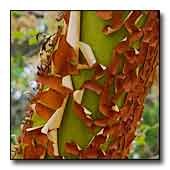
Quick Jumps
Growing Guide
Rainy Side Notes
GROWING GUIDE
Origin:
British Columbia, California, Oregon and Washington
Plant Group:
Trees.
Hardiness:
Sunset zones: 4-7, 14-19.
USDA zones: 7-9.
Heat zones: 9-7.
Mature size:
Height: 50-100 feet (15-30 m), cultivated trees stand 20-50 feet (6-15 m).
Width: up to 50 feet (15 m).
Flowering period:
May.
Flowering attributes:
Greenish-white, ¼" long, sweetly fragrant flowers on panicles are followed by pea-sized red fruits turning red in fall and remaining on the tree well into winter.
Leaf attributes:
Glossy, evergreen, alternate, simple, 2 to 6-inch long leaves. Dark green above and glaucous to white underneath.
Light:
Full sun.
Soil:
Dry, infertile soil.
Propagation Methods:
Stratify seeds naturally outdoors over winter for 30-90 days. Scarification with sulfuric acid does NOT help in germination.
Semi-ripe cuttings in summer.
Layering.
Pruning Methods:
Keep pruning to a minimum; however, if you need to prune out wayward or crossing stems, do so in late winter or early spring
Pests and Diseases:
Nattrassia mangiferae is an endemic fungus that is causing problems with our native madronas. Phytophthora cactorum–root rot and cankeris–another possible problem for the tree.
Rainy Side Notes
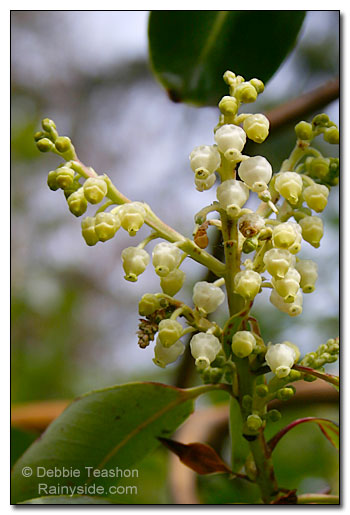
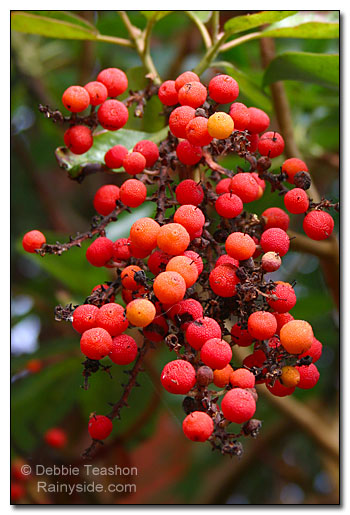
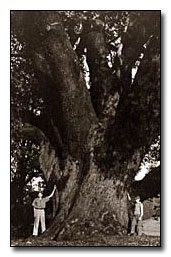
The Latin name Arbutus means strawberry tree for its red fruits. Its epithet, menziesii, was named after the first European who discovered it, Archibald Menzies, a naturalist for the Vancouver expedition. In 1792, Vancouver found and explored the Puget Sound region.
The common names madrone and madrona come from the Spanish word for strawberry tree, madrono, because it resembles Arbutus unedo, a Mediterranean strawberry tree.
In British Columbia, the broadleaf, evergreen trees are commonly called Arbutus. In Washington and Oregon, they are called madrona, and in California, madrone. No matter what we call them, they are magnificent trees that grow naturally along the bluffs of our waterways. Magnolia Bluff, a neighborhood in Seattle overlooking Puget Sound, was misnamed because of a navy geographer. In the 1850s, the man spotted the madronas while he was on a ship on the Puget Sound, and unfortunately, he misidentified the trees as magnolias.
In the wild, our native Pacific madrone grows into large noble trees. The majority grow 50-75 feet tall. However, In Humboldt County, California (see black and white photo right), one tree grows 96 feet tall by 113 feet wide; its trunk measures 24 feet and is estimated to be about 600 years old. I was in Humboldt County once; they super-size everything down there. Unfortunately, the madrone was split into pieces by a windstorm on February 3, 2000.
For wildlife, this tree is essential. In spring, deer eat the blossoms, and what the deer leave behind, the bees pollinate; hummingbirds feed on the nectar. From the pollinated flower follows the red fruit, which supplies many types of birds and other animals, such as squirrels, mule deer, raccoon, ringtail, band-tailed pigeon, American robin, varied thrush and Montezuma quail. Insects, such as the brown elfin caterpillar, use Arbutus menziesii's leaves as a food source.
Leaves stay on the tree for two years, after which they turn orange and red and fall off between June and July.
Medicinally, Arbutus menziesii is used as an astringent, a tea for bladder infections, and as a sitz bath for other types of infections.
The wood is used for a variety of items, such as furniture and carving; it is even a safe wood for caged birds. The fruit is also used to make jelly.
Ethnobotany
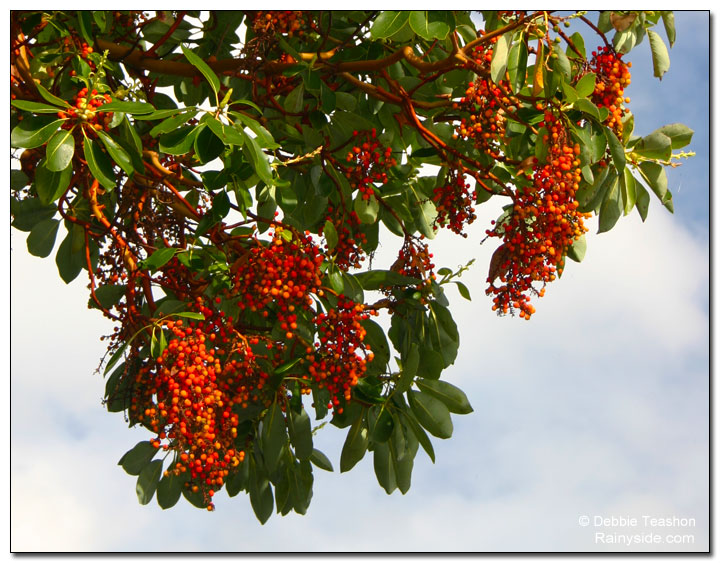
The Salish of Vancouver Island used the bark to cook camas bulbs, turning them pinkish. Other indigenous tribes used it medicinally for colds and stomach problems and even as a postpartum contraceptive.
In the Garden
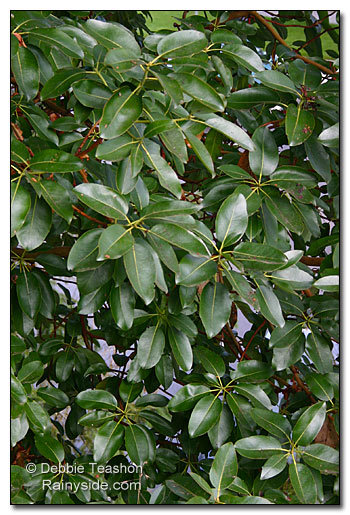
As a cultivated tree, it usually doesn't reach over 50 feet tall. The species is difficult to grow in garden settings because of too much irrigation for its liking. It is necessary to start with a small seedling, as older trees do not transplant well and are difficult to establish. Little seedlings are painstakingly slow to grow, as I am finding out with one I planted three years ago that seems to have gained only a few inches in stature in that period. Give it a dry, well-drained spot in the garden with minimal irrigation. If you must water, do so infrequently and give a deep soaking.
Native madronas contribute to cliff and bluff stability. The roots go deep, clear to bedrock, in search of water. Many of these trees suffer in urban settings or are chopped down for development. Removing these trees causes the bluffs overlooking the water to become more susceptible to landslides. Since Arbutus is one of the best trees successfully grown in these arid conditions, we should work to save them from the ax by educating developers and landowners of bluff sites about the importance of keeping these trees.
Photographed on the Olympic and Kitsap Peninsulas, Washington.
A Pacific Northwest Plant of the Week (2011)
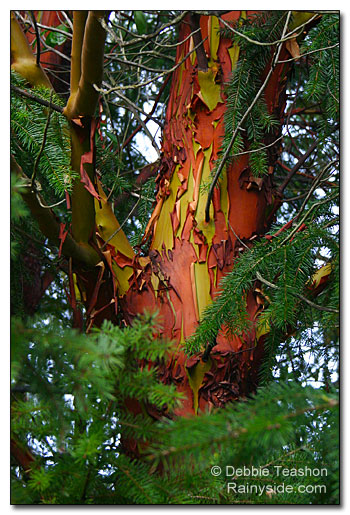
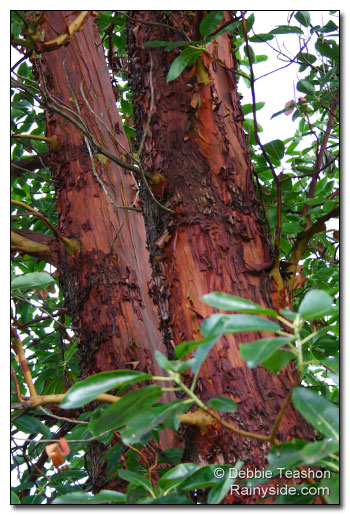
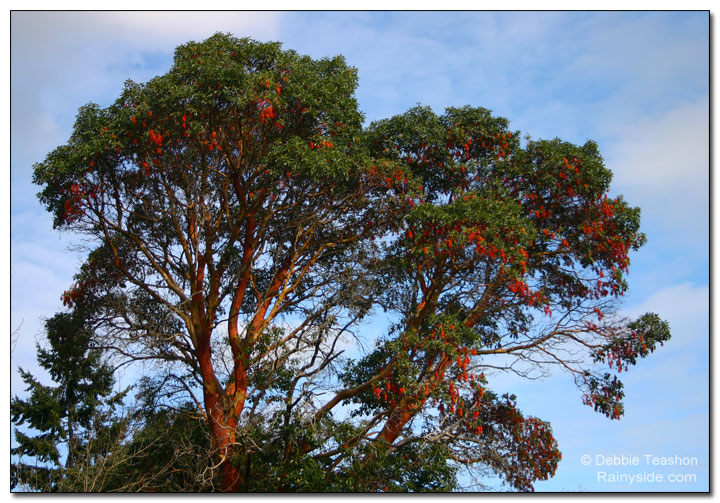
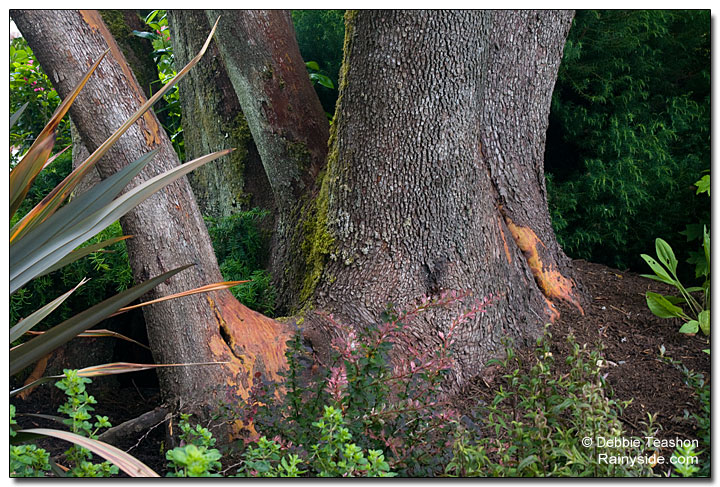

Gardening for the Homebrewer: Grow and Process Plants for Making Beer, Wine, Gruit, Cider, Perry, and More
By co-authors Debbie Teashon (Rainy Side Gardeners) and Wendy Tweton
Copyright Notice | Home | Search | Natives

